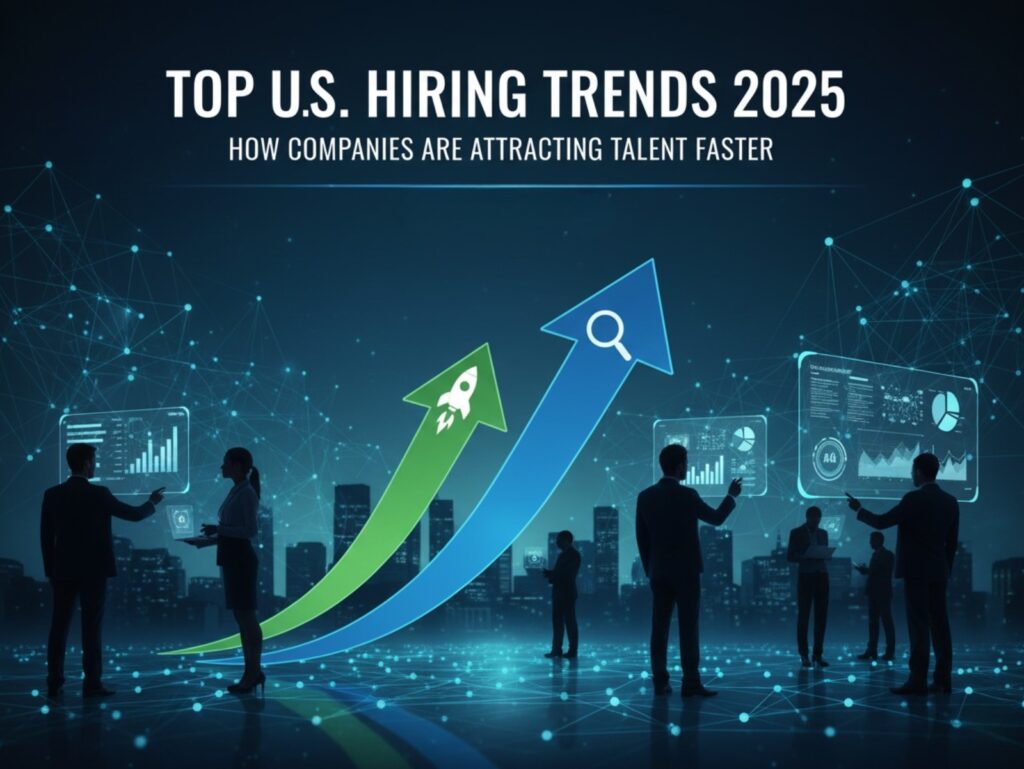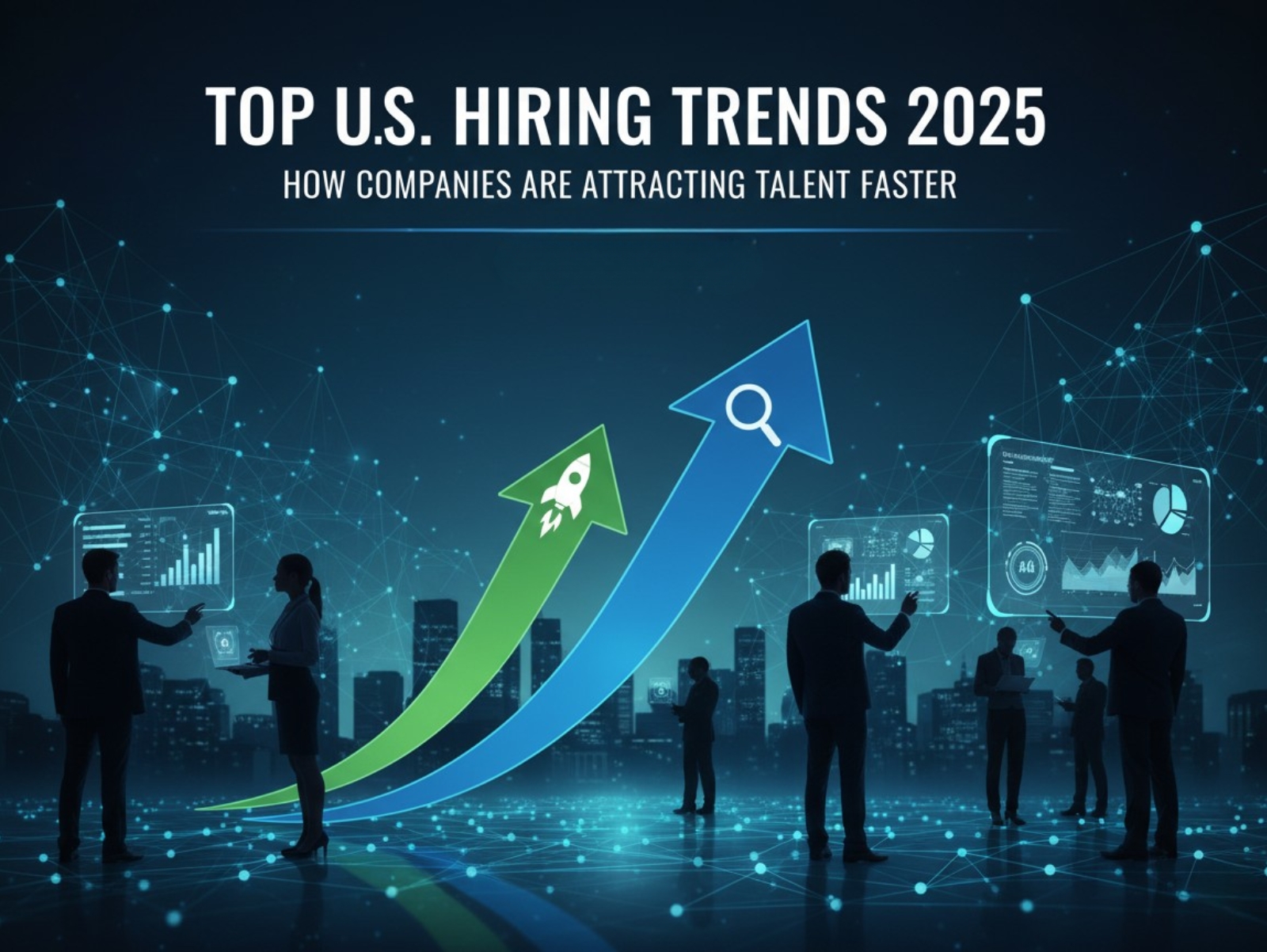
Top U.S. Hiring Trends 2025: How Companies Are Attracting Talent Faster
The U.S. job market in 2025 looks very different from just a few years ago. Driven by technology, flexible work models, and shifting candidate expectations, companies are completely rethinking how they attract, hire, and retain talent. Are you looking to hire in Austin, Texas? Or maybe Los Angeles, California? These hiring trends will impact your hiring in these cities, too!
Recruitment is no longer just about filling open roles – it’s about building an adaptable, data-driven workforce that evolves with the business. Whether you’re a growing startup in Silicon Valley or a Fortune 500 enterprise in New York City, understanding the latest U.S. hiring trends for 2025 can help you stay ahead in an ultra-competitive talent market.
1.AI Recruiting Takes Centre Stage
Artificial intelligence is no longer a futuristic idea – it’s now a critical tool in the modern hiring process. In fact, many companies are reducing the time to hire by 50% by implementing AI technology.
AI recruiting platforms analyse massive data sets, predict hiring success, and automate time-consuming tasks like resume screening, skill matching, and candidate communication.
In 2025, over 70% of U.S. companies report using AI in at least one stage of recruitment. From chatbots scheduling interviews to predictive analytics assessing candidate fit, the impact is clear – faster hiring, reduced bias, and better outcomes.
Key Benefits of AI Recruiting in 2025:
- Automates repetitive HR tasks
- Reduces human bias during screening
- Enhances candidate experience through personalisation
- Predicts employee performance and retention

2. Remote and Hybrid Work Are Now the Norm
The pandemic permanently reshaped the American workplace. By 2025, remote and hybrid work will no longer be perks – they’ll be the standard expectation for knowledge-based roles. This is especially important if you are hiring in cities like San Francisco, California or Boulder, Colorado, where employees have come to expect remote opportunities.
Employees value flexibility, autonomy, and location freedom, while employers enjoy access to a larger talent pool nationwide.
Companies that refuse to adapt risk losing candidates to more flexible competitors. Even industries that were once office-bound (like finance and government contracting) are now embracing hybrid schedules.
Top remote-friendly roles in 2025:
- Software engineering
- Marketing & content strategy
- HR and recruitment coordination
- Customer experience (CX) management
To attract the best talent, employers are redesigning job descriptions with clear hybrid policies and location-flexible keywords such as “remote U.S. jobs,” “hybrid work roles,” and “work from anywhere opportunities.”
Looking for remote talent? Bluebix Solutions specialises in finding top candidates for remote and hybrid roles. Learn more about our remote staffing solutions.

3. Skills-Based Hiring Replaces Degree Requirements
The era of degree-centric hiring is fading. Companies now value skills, certifications, and real-world experience over traditional education credentials.
A LinkedIn survey shows that 60% of U.S. employers are removing degree requirements from job postings. Instead, they focus on competency tests, portfolio reviews, and micro-credentials (like Google Career Certificates or AWS certifications).
Companies Leading the Way in Skills-Based Hiring:
- Google: Focuses on skills and experience for many roles.
- IBM: Emphasis on practical skills and certifications.
Example:
A candidate with CompTIA or Microsoft certifications may now outperform a 4-year degree holder for IT or cybersecurity roles.
Why this matters:
- Expands your talent pool
- Encourages diversity and inclusion
- Attracts career-changers and self-taught professionals

4. Contract, Temp, and Gig Work Are Growing Rapidly
Flexible hiring models are one of the most important U.S. hiring trends in 2025.
More companies are building “elastic” teams by blending full-time employees with contractors, freelancers, and temp-to-hire professionals. This allows them to stay agile during market fluctuations while cutting overhead costs.
Industries Leading in Flexible Workforce Growth in the U.S.:
- Healthcare staffing
- IT & software development
- Logistics & manufacturing
- Customer support and sales
Staffing firms like Bluebix Solutions help employers scale quickly by maintaining a ready-to-deploy talent pipeline. For candidates, this opens the door to short-term opportunities that can turn into long-term careers.

5. Candidate Experience Is the New Competitive Advantage
In 2025, the hiring journey itself is a deciding factor for many job seekers. A poor experience – slow response times, unclear communication, or unstructured interviews – can drive top candidates away. In fact, 78% of candidates say the overall candidate experience is an indicator of how a company values its people.
Forward-thinking employers are investing in candidate experience platforms that make job applications easier, feedback faster, and communication more transparent.
Tips for enhancing candidate experience:
- Use mobile-friendly application forms
- Send automated “application received” messages
- Offer interview preparation guides
- Provide post-interview follow-ups
Remember: A positive candidate experience doesn’t just fill jobs—it builds brand advocates.

6. Diversity, Equity & Inclusion (DEI) Remain a Hiring Priority
Diversity in recruitment has matured from a “compliance checkbox” into a strategic business advantage.
In 2025, companies that prioritise diverse hiring practices are seeing measurable improvements in innovation, retention, and profitability. Companies with diverse teams are 35% more likely to outperform their competitors. [Source link].
AI tools now help remove bias from job descriptions and candidate shortlists, while staffing agencies specialising in inclusive sourcing ensure representation across gender, ethnicity, age, and ability.
Actionable DEI practices:
- Use gender-neutral job descriptions
- Include diverse imagery in employer branding
- Partner with diversity-focused staffing firms
- Offer mentorship and leadership programs for underrepresented groups

7. Data-Driven Recruitment Is Reshaping HR Decisions
The most successful HR teams in 2025 use data—not instinct—to make hiring decisions.
Recruiters now rely on analytics dashboards that measure:
- Time-to-hire
- Source of hire (job board, referral, or agency)
- Cost-per-hire
- Candidate engagement rate
This helps companies identify where talent comes from and where bottlenecks occur.
By integrating data from ATS platforms, CRMs, and job analytics tools, HR leaders can make faster, smarter hiring decisions.

8. Staffing Partnerships Drive Competitive Advantage
As hiring becomes more specialised and complex, U.S. employers increasingly rely on staffing and recruitment partners to navigate talent shortages.
Staffing agencies like Bluebix Solutions act as strategic extensions of in-house HR teams, combining automation with personalised recruitment to deliver the right candidates at the right time.
Advantages of staffing partnerships in 2025:
- Shorter time-to-fill
- Pre-vetted, skilled candidates
- Scalable workforce options (temp, contract, permanent)
- Compliance and onboarding support
The best partnerships are not transactional—they’re collaborative and long-term, built around shared success metrics.

9. Employee Retention Starts During Recruitment
Finally, the new mindset in 2025: Retention begins on day one.
The most successful companies focus on matching not just skills but culture, values, and growth mindset during hiring. Employers now evaluate candidates holistically, ensuring mutual fit before the offer stage.
Retention strategies include:
- Personalised onboarding programs
- Early career mentorship
- Internal mobility & training opportunities
- Regular pulse surveys
Result: Lower turnover, stronger loyalty, and higher ROI per hire.

Conclusion: The Future of Hiring Is Agile and Human-Centred
The U.S. hiring landscape in 2025 is a balance of technology, flexibility, and human connection.
Companies that embrace AI, focus on candidate experience, and adopt agile workforce models will lead the talent race. Whether through advanced recruitment platforms or partnerships with agencies like Bluebix Solutions, success lies in building a hiring ecosystem that’s faster, smarter, and more human.
Download our FREE guide: “5 Steps to Future-Proof Your Hiring Strategy.
FAQ Section
Q1. What are the top hiring trends in the U.S. for 2025?
AI recruiting, hybrid work, skills-based hiring, flexible workforce models, and data-driven recruitment are among the leading trends.
Q2. How can AI improve the hiring process?
AI speeds up screening, improves accuracy, and reduces human bias—helping recruiters focus on candidate engagement.
Q3. What industries are hiring the most in 2025?
Technology, healthcare, logistics, finance, and renewable energy remain the top U.S. job-creating industries.
Q4. Why should companies partner with staffing agencies?
Staffing agencies provide pre-qualified candidates, reduce time-to-hire, and ensure compliance—especially for large-scale or temp hiring. Find out how Bluebix Solutions can help you.
Q5. How can small businesses compete for talent?
By offering flexible schedules, remote work, strong employer branding, and partnerships with specialised staffing firms.











